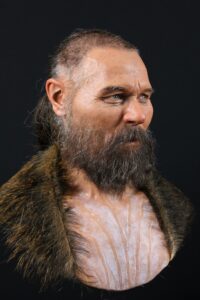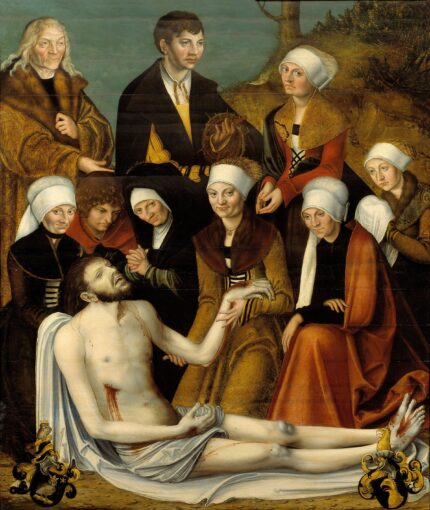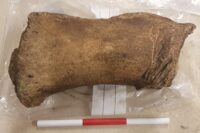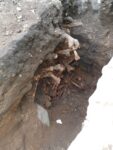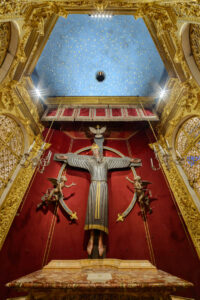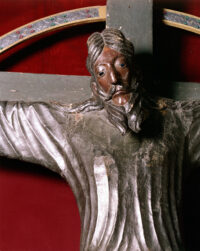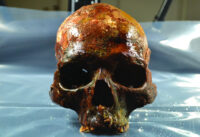 The Kanaljorden site in southern central Sweden is adjacent to the Motala river, a small lake and a wetland today. In the Neolithic era (ca. 7700 years ago), it was a very shallow lake just three feet deep lake next to a reed fen. The Mesolithic population didn’t just use the small as-is for ritual depositions. They built a sort of platform of densely packed stones on the lake bed first, and then deposited human and animal remains in the water.
The Kanaljorden site in southern central Sweden is adjacent to the Motala river, a small lake and a wetland today. In the Neolithic era (ca. 7700 years ago), it was a very shallow lake just three feet deep lake next to a reed fen. The Mesolithic population didn’t just use the small as-is for ritual depositions. They built a sort of platform of densely packed stones on the lake bed first, and then deposited human and animal remains in the water.
The site was excavated between 2009 and 2014. Archaeologists discovered the stone floor, a plethora of objects — tools made of stone, antler and bone, harpoon and spear tips — and the disarticulated skeletal remains at least nine adult humans and the almost complete articulated skeleton of a neonate or stillbirth. The bones of at least 14 animals of seven different species (wild boar, brown bear, red deer, roe deer, moose, badger) were also scattered on the stone construction. The dates of the finds range from 8,000 to 7,500 years ago.
Very few human burials from Mesolithic Scandinavia have been archaeologically investigated — only 200 or so from the 3,000 year span (9,000-6,000 years before present) — so information about the funerary practices of the hunter-gatherer population is scarce. The Motala finds were well-preserved by the wetland conditions, giving archaeologists a rare opportunity to learn about their lives — diet, age at time of death, sex, injuries — and deaths.
The osteological finds are also very unusual as most Scandinavian Mesolithic burials are full-body inhumations, but the adult remains at Kanaljorden predominantly consist of crania and fragments there of, all missing their mandibles. There is evidence of antemortem blunt force trauma on seven individuals. Of those seven, four evinced shallow injuries and healed injuries on or near the top of the head, two had multiple wounds on the back of the head. The ones with trauma to the back of the head were both female. There are only a few potential instances of sharp force trauma on the bones, and the cuts are very shallow and could have been postmortem. There is plenty of evidence of sharp force trauma on the animal remains indicating they were butchered. The animals remains also included mandibles, so the disarticulation of the human jawbones seems to have been deliberate.
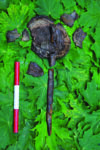 Two of the crania recovered had wooden stakes inside of them. One had an intact stake 18.5 inches long embedded in the cranium. The other end of it was pointed. The second stake was broken and what was left of it was only discovered in the laboratory when the inside of the skull was examined. The skulls had been mounted on those stakes. The remains of hundreds more wooden stakes, 400 of them intact, were also unearthed at the site, although without any handy tell-tale skulls attached. Archaeologists believe some were likely used to mount remains for ritual purposes; others appear more likely to have been remnants of fences or other wooden construction.
Two of the crania recovered had wooden stakes inside of them. One had an intact stake 18.5 inches long embedded in the cranium. The other end of it was pointed. The second stake was broken and what was left of it was only discovered in the laboratory when the inside of the skull was examined. The skulls had been mounted on those stakes. The remains of hundreds more wooden stakes, 400 of them intact, were also unearthed at the site, although without any handy tell-tale skulls attached. Archaeologists believe some were likely used to mount remains for ritual purposes; others appear more likely to have been remnants of fences or other wooden construction.
A local museum in the town of Motala has commissioned archaeologist and sculptor Oscar Nilsson to do a facial reconstruction of the one of the skulls on a stake. DNA analysis determined that this individual, dubbed Ludvig, was light-skinned and blue-eyed. Nilsson took a CT scan of the skull and 3D-printed a replica to use as the base for the reconstruction of muscular tissue and skin. He calculated the proportions of Ludvig’s missing mandible by measuring the cranium. The wild boar coat was inspired by the remains of that animal found at the site.
